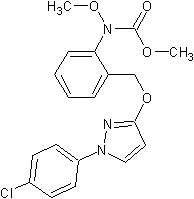| Common
Name: |
Pyraclostrobin
|
| Chemical
Name: |
methyl N-[2-[[[1-(4-chlorophenyl)-1H-pyrazol-3-yl]oxy]methyl]phenyl]-N-methoxycarbamate
|
| CAS
No.: |
175013-18-0
|
| Structure: |

|
| Molecular
Weight: |
387.8
|
| Physical
Chemistry: |
Technical Pyraclostrobin is a white or light beige solid. Vapour Pressure:2.6×10-5 mPa (20C) . Melting Point: 63.7-65.2 C.Solubility in
water: 1.9 mg/l (20C). In n-heptane 3.7, isopropanol 30.0, octanol 24.2, olive oil 28.0, methanol 100.8, acetone, ethyl acetate, acetonitrile, dichloromethane and toluene >500 (all in g/l, 20C).
|
| Toxicity: |
Pyraclostrobin has low acute toxicity when administered orally or dermally, with LD50s of > 5000 and > 2000 mg/kg bw respectively, and no deaths in either case. The compound has moderate toxicity when administered by inhalation, with an LC50 of 0.31-1.07 mg/l when acetone is used as the solvent, and 4.07-7.3 mg/l when Solvesso is used as the solvent. Pyraclostrobin is a mild skin and eye irritant, but is not a skin sensitizer. |
| Application: |
Pyraclostrobin is a broad-spectrum fungicide, controlling major plant pathogens from the ascomycete, basidiomycete, deuteromycete and oomycete classes of fungi. The product has protective, curative, eradicative, translaminar and locosystemic properties.
|
| Technical
Purity: |
95%Tech
|
| Formulation
Type: |
25%EC
| |



